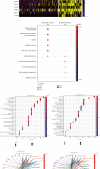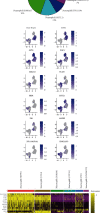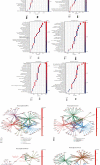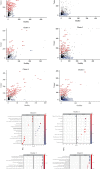Transcriptional Profiling Reveals Kidney Neutrophil Heterogeneity in Both Healthy People and ccRCC Patients
- PMID: 33791390
- PMCID: PMC7984911
- DOI: 10.1155/2021/5598627
Transcriptional Profiling Reveals Kidney Neutrophil Heterogeneity in Both Healthy People and ccRCC Patients
Abstract
Neutrophil is known to critically impact the development of renal diseases (e.g., the clear cell renal cell carcinoma (ccRCC)), whereas the heterogeneity of neutrophils in ccRCC remains unclear. In the present study, kidney biopsies from healthy donors and ccRCC tissues were collected for single-cell RNA sequencing (scRNA-seq). In addition, the subpopulations of neutrophils in a healthy kidney and in the tumor microenvironment (TME) of ccRCC were expressed and then analyzed. The genes reported previously were mapped to all subpopulations identified here. On that basis, biological theme comparison and Gene Set Enrichment Analysis (GSEA) were employed to reveal and compare relevant biological functions. In a healthy kidney, neutrophils exhibit two subpopulations: one is more associated with renal autoimmunity, probably acting as therapeutic target; the other is suggested to resist infectious microorganisms. It is noteworthy that six subpopulations were identified in ccRCC biopsy, and two were more relevant to autoimmunity, while the other four are more relevant to the tumor pathology. Besides, ccRCC neutrophil could resist anticancer immune therapies of ipilimumab and pembrolizumab for their low/no expressions of CTLA-4, PD-1, and PD-L1. Thus, this study can help understand the heterogeneity and pathological significance of neutrophils in renal diseases.
Copyright © 2021 Yiliang Meng et al.
Conflict of interest statement
The authors declare that this research was conducted in the absence of any commercial or financial relationships that could be construed as a potential conflict of interest.
Figures





Similar articles
-
TUBA1C orchestrates the immunosuppressive tumor microenvironment and resistance to immune checkpoint blockade in clear cell renal cell carcinoma.Front Immunol. 2024 Sep 5;15:1457691. doi: 10.3389/fimmu.2024.1457691. eCollection 2024. Front Immunol. 2024. PMID: 39301023 Free PMC article.
-
Spatially segregated APOE+ macrophages restrict immunotherapy efficacy in clear cell renal cell carcinoma.Theranostics. 2025 Apr 13;15(11):5312-5336. doi: 10.7150/thno.109097. eCollection 2025. Theranostics. 2025. PMID: 40303328 Free PMC article.
-
Roles of the Dynamic Tumor Immune Microenvironment in the Individualized Treatment of Advanced Clear Cell Renal Cell Carcinoma.Front Immunol. 2021 Mar 4;12:653358. doi: 10.3389/fimmu.2021.653358. eCollection 2021. Front Immunol. 2021. PMID: 33746989 Free PMC article. Review.
-
Integrated analysis of immune-related gene subtype and immune index for immunotherapy in clear cell renal cell carcinoma.Pathol Res Pract. 2021 Sep;225:153557. doi: 10.1016/j.prp.2021.153557. Epub 2021 Jul 20. Pathol Res Pract. 2021. PMID: 34329838
-
Good cops turn bad: The contribution of neutrophils to immune-checkpoint inhibitor treatment failures in cancer.Pharmacol Ther. 2021 Jan;217:107662. doi: 10.1016/j.pharmthera.2020.107662. Epub 2020 Aug 15. Pharmacol Ther. 2021. PMID: 32805297 Review.
Cited by
-
The Role of Cytokines in Neutrophil Development, Tissue Homing, Function and Plasticity in Health and Disease.Cells. 2023 Jul 31;12(15):1981. doi: 10.3390/cells12151981. Cells. 2023. PMID: 37566060 Free PMC article. Review.
-
Integrated analysis of the roles of oxidative stress related genes and prognostic value in clear cell renal cell carcinoma.J Cancer Res Clin Oncol. 2023 Oct;149(13):11057-11071. doi: 10.1007/s00432-023-04983-w. Epub 2023 Jun 20. J Cancer Res Clin Oncol. 2023. PMID: 37340189 Free PMC article.
-
Heterogeneity in NK Cell Subpopulations May Be Involved in Kidney Cancer Metastasis.J Immunol Res. 2022 Aug 22;2022:6378567. doi: 10.1155/2022/6378567. eCollection 2022. J Immunol Res. 2022. PMID: 36046723 Free PMC article.
-
External Validation of the Prognostic Value of an Immune-Associated Gene Panel for Clear Cell Renal Cell Carcinomas.Front Cell Dev Biol. 2021 Dec 23;9:794840. doi: 10.3389/fcell.2021.794840. eCollection 2021. Front Cell Dev Biol. 2021. PMID: 35004689 Free PMC article.
-
High-resolution Slide-seqV2 spatial transcriptomics enables discovery of disease-specific cell neighborhoods and pathways.iScience. 2022 Mar 16;25(4):104097. doi: 10.1016/j.isci.2022.104097. eCollection 2022 Apr 15. iScience. 2022. PMID: 35372810 Free PMC article.
References
MeSH terms
Substances
LinkOut - more resources
Full Text Sources
Other Literature Sources
Medical
Research Materials

